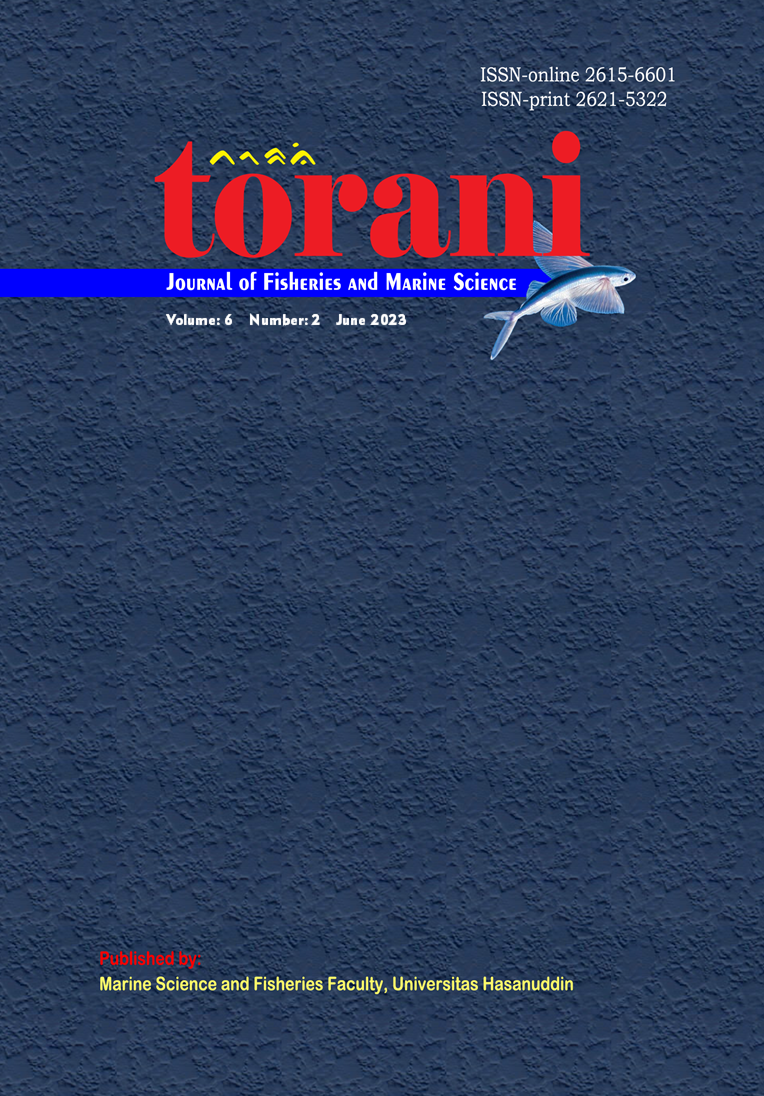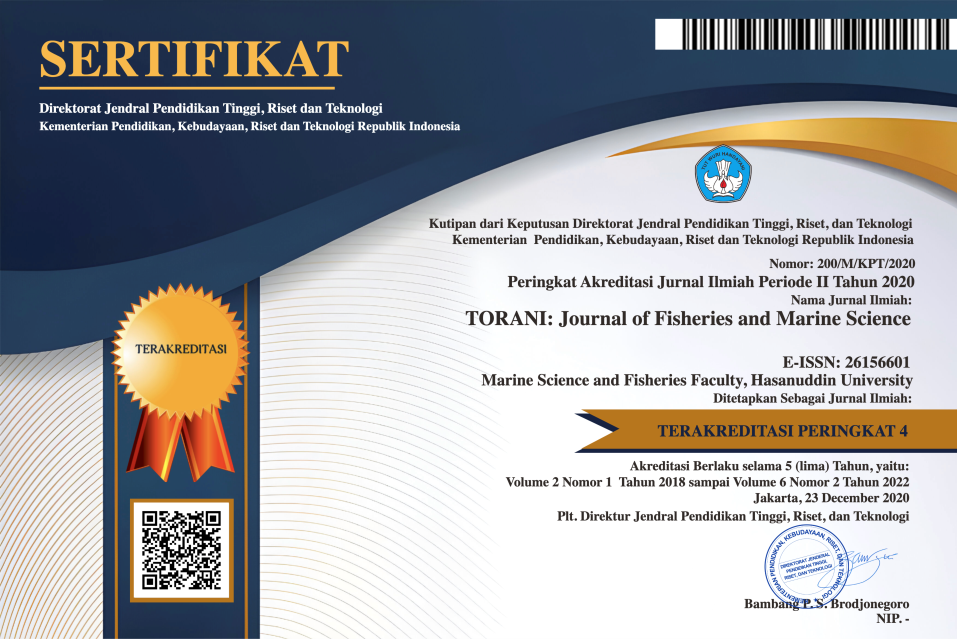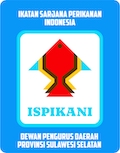Digestibility of Feed Supplemented with Common Pleco Meal and Its Impact on The Growth of Nile Tilapia (Oreochromis sp.)
DOI:
https://doi.org/10.35911/torani.v6i2.26091Keywords:
artificial feed, fish meal, common pleco, tilapiaAbstract
Common pleco is a wild fish whose habitat occupies a lot of reservoir areas and public waters in Indonesia. The amount is abundant and not consumed by humans, is a great potential to be used as a source of animal protein in fish feed. The purpose of this study was to evaluate the digestibility of common pleco fish meal in artificial feed for nile tilapia (Oreochromis niloticus.) The study was carried out at the Aquaculture Laboratory Hatchery, Faculty of Fisheries and Marine Sciences, Universitas Padjadjaran, while the manufacture of common pleco meal, proximate analysis of feed ingredients and the test feed was carried out by the Laboratory of Chemistry and Animal Feed, Faculty of Animal Husbandry, Universitas Padjadjaran. The design used in this study was a Completely Randomized Design (CRD) consisting of 5 (five) treatments and 3 (three) replications. The treatment given was the addition of common pleco flour in artificial feed at 0%, 5%, 10%, 15% and 20%. The parameters observed in this study consisted of digestibility, growth rate, and water quality. The results of the research on some of these parameters indicate that the addition of common pleco meal can still be used in artificial feed up to 10%. The tilapia studied had the highest relative growth with a value of 0.218%. The digestibility level of the studied feed reached a value of 85.256%, and the water quality studied was still within the safe tolerance limits for fish farming. Based on the results of this study, the negative effect on the survival rate of tilapia did not occur until the addition of common pleco flour to artificial feed reached 10%. Thus, the fish meal has the potential as an alternative to fish meal in fish feed formulations.
References
Adawyah R. 2008. Pengolahan dan Pengawetan Ikan. Jakarta: Bumi Aksara.
Ediwarman S, Novita P. 2021. Penggunaan Metionin dan Lisin pada Pakan Mandiri Berbasis Bahan Baku Lokal Terhadap Pertumbuhan dan Efisiensi Pakan Pada Pembesaran Ikan Patin Siam (Pangasianodon hypophthalmus). Jurnal Akuakultur Sungai dan Danau, 6(1): 9-18
Rahmatia F. 2016. Evaluasi Kecernaan Pakan Ikan Nila Oreochromis niloticus pada Tiga Stadia yang Berbeda. Jurnal Ilmiah Satya Minabahari, 1(2): 43-51.
Haetami K. 2004. Evaluasi Kecernaan Tepung Azola dalam Ransum
Ikan Bawal Air Tawar (Colossoma macropomum, Cuvier 1818). [Artikel Ilmiah]. Fakultas Pertanian. Universitas Padjadjaran.
Hasanah M. 2018. Potensi Ikan Sapu-Sapu (Pterygoplichthys pardalis) Berbagai
Ukuran dari Sungai Ciliwung Sebagai Sumber Asam Lemak Esensial. [Skripsi]. Jakarta: Program Studi Biologi Fakultas Sains dan Teknologi Universitas Islam Negeri Syarif Hidayatullah Jakarta.
Hasnidar, Andi T, Akram AM, Hidayat T. 2021. Analisis Kimia Ikan Sapu-Sapu (Pterygoplichthys pardalis Castelnau 1855) dari Danau Tempe Sulawesi Selatan, Indonesia. JPHPI, 24(1): 78-88.
Hutasoit D, Yusni E, Lesmana I. 2015. Pengaruh Penambahan Tepung Ikan Sapu-Sapu (Lyposarcus pardalis) pada Pakan Komersil terhadap Pertumbuhan Ikan Patin (Pangasius sp.). Jurnal Aquacoastmarine, 6(1):1-9
Kusharto CM. 2006. Serat makanan dan peranannya bagi kesehatan. Jurnal Gizi dan Pangan. 1(2): 45-54.
NRC. 1983. Nutrient Requirement of Warmwater Fishes. Washington DC: National Academy Science.
Ranjhan SK. 1980. Animal Nutrition in Tropics, 2nd Revised Edition. New Delhi: Vicas Publishing House PVT. Ltd.
Schneider BH, Flatt WP. 1973. The Evaluation of Feeds Through Digestibility Experiment. New York: The University of Georgia Press.
Scott ML, Neisheim MC,Young RJ. 1982. Nutrition of The Chickens. 2nd Ed. Ithaca, New York: M.L. Scott and Assoc.
Sihite HH. 2013. Studi pemanfaatan limbah ikan dari Tempat Pelelangan Ikan (TPI) dan pasar tradisional Nauli Sibolga menjadi tepung ikan sebagai bahan baku pakan ternak. Jurnal Teknologi Kimia Unimal. 2(2): 43–54
Tisasari M, Efizon D, Pulungan CP. 2016. Stomach Content Analysis of
Pterygoplichthys pardalis from The Air Hitam River, Payung Sekaki District,
Riau Province. Jurnal Online Mahasiswa Fakultas Perikanan dan Ilmu
Kelautan, 3(1):1-14.
Pramleonita M, Yuliani N, Arizal R, Wardoyo SE. 2018. Parameter Fisika dan Kimia Air Kolam Ikan Nila Hitam (Oreochromis niloticus). Jurnal Sains Natural, 8(1): 24–34
Putra WP, Nopianti R, Herpandi. 2017. Kandungan Gizi dan Profil Asam Amino Tepung Ikan Sepat Siam (Trichigaster pectoralis). FishtecH – Jurnal Teknologi Hasil Perikanan 6(2):174-185.
Rahmatia. 2016. Evaluasi Kecernaan Pakan Ikan Nila (Oreochromis niloticus) Pada Tiga Stadia yang Berbeda. Jurnal Satya Minabahari, 01(2):43-51.
Wahyudewantoro G. 2018. Sapu-sapu (Pterygoplichthys spp.), Ikan Pembersih Kaca yang Bersifat Invasif di Indonesia. Warta Ikhtiologi, 2(2): 22-28
Wu LW, Liu CC, Lin SM. 2011. Identification of exotic sailfin catfish species (Pterygoplichthys, Loricariidae) in Taiwan based on morphology and mtDNA sequences. Zoological Studies, 50(2): 235–246
Yolanda S, Santoso L, Harpeni E. 2013. Pengaruh Substitusi Tepung Ikan dengan Tepung Ikan Rucah Terhadap Pertumbuhan Ikan Nila Gesit (Oreochromis niloticus). e-Jurnal Rekayasa dan Teknologi Budidaya Perairan, 1(2): 95-100















